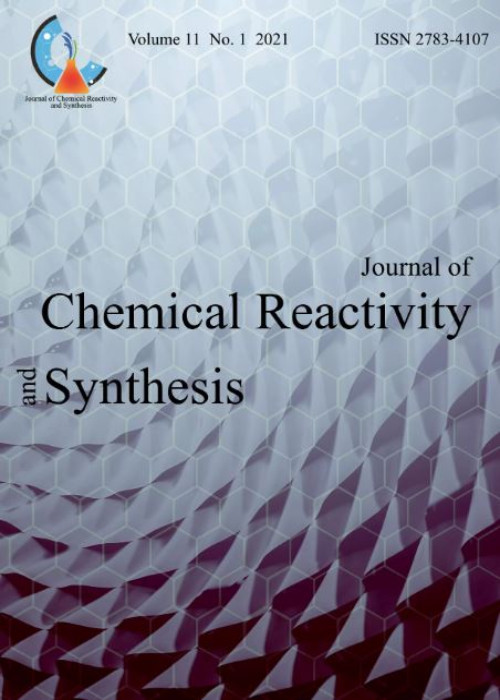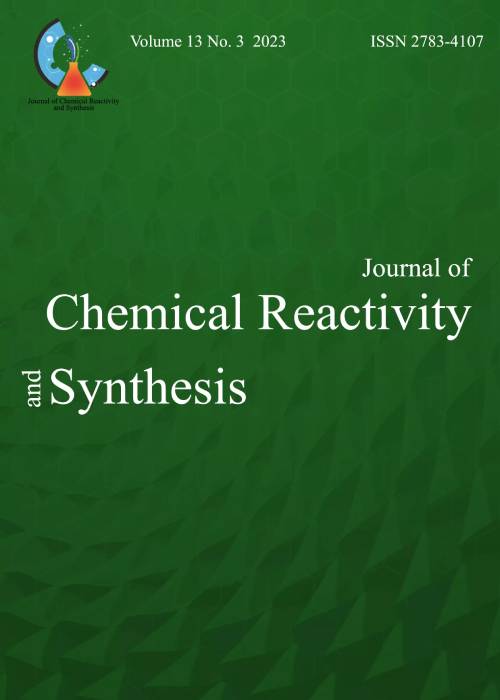فهرست مطالب

Journal of Chemical Reactivity and Synthesis
Volume:11 Issue: 1, Winter 2021
- تاریخ انتشار: 1399/12/11
- تعداد عناوین: 6
-
Pages 1-5
In this study, a simple and efficient approach is reported to product graphene using electrochemical exfoliation of graphite electrodes, in acidic solutions. The electrolyte concentration, applied voltages, electrodes distance and preparation time were taken as control parameters to optimize the produced graphene structures. The optimized graphene sample was prepared in a H2SO4 (0.5 M) at a bias of +10 V. The interlayer spaces, crystallite size and the average number of layers were determined by XRD. Surface morphology, layer thickness and characteristics of obtained samples were investigated by Scanning Electron Microscopy (SEM), Atomic Force Microscopy (AFM), and FTIR. The obtained results confirmed the graphene structures.
Keywords: Graphene, Graphite Electrode, Electrochemical Synthesis, electrochemical saving energy -
Pages 6-11
During the past decades organic nonlinear optical (NLO) materials have been attracted much attention because NLO materials have potential applications in the field of optoelectroni. Experimental measurements and theoretical calculations on molecular hyper polarizability become one of the key factors in the NLO materials design. Theoretical determination of hyper ploarizability is quite useful both in understanding the relationship between the molecular structure and nonlinear optical properties. Several organic derivatives are designed with large first hyper polarizability (β). Among the interesting type of organic materials, charge transfer complexs (CTC) have recently been identified as promising NLO materials. The present study is dedicated to perform a theoretical investigation using B3LYP/6- 311G++ (d, p) level of theory, about the linear and nonlinear optical properties, represented as dipole moment (μ), α, and β of CTCs of, tetracyano quinodimethane derivatives (TCNQ, 1) and tetrathiafulualene (TTF, 2). Our aim is designing new NLO materials that can be synthesized in future.
Keywords: tetrathiafulualene (TTF), tetracyanoquinodimethane (TCNQ), polarizability, Hyperpolarizability, charge transfer complex, and DFT -
Pages 12-17Reaction of 3,6-dichloropyridazine with hydrazine gave 1-(6-chloropyridazin-3-yl) hydrazine in high yield in ethanol at room temperature. Diazotization of the latter compound converted it to 6-chlorotetrazolo[1,5-b]pyridazine quantitatively in ice bath. 6-Chlorotetrazolo[1,5-b]pyridazine underwent a chlorine substitution is ethanol with amines at room temperature.The reaction mechanism and spectral data is discussed.Keywords: 3, 6-dichloropyridazine, diazotization, tetrazolo[1, 5-b]pyridazine, Hydrazine
-
Pages 18-25
The partitioning of iodide was studied in an aqueous two phase system (ATPS) comprised of ammonium sulphate, poly ethylene glycol dimethyl ether (PEGDME), and water at 298.15 K. To investigate the effect of molar mass of the polymer on the tie-line, similar measurements were also made at T=298.15 K on this two phase system consisting of the PEGDME with molar masses of 250, 500 and 2000 g.mol-1. Finally the effect of molar mass of polymer on the binodal of {PEGDME + ammonium sulphate +water} was studied by measuring liquid-liquid equilibrium at T= 298.15 K for three different molar masses. The experimental binodal data were described using two empirical nonlinear three parameter expressions developed by Merchuk and Zafarani Moattar et al. The increase in the polymer molar mass provides ATPS with larger biphasic region. The tie-line compositions were estimated and correlated using the Othmer–Tobias and Bancroft and Setschenow type equations. In addition the partitioning behavior of the iodine molecule on the investigated aqueous two-phase system was studied.
Keywords: Liquid-liquid equilibrium, Ammonium sulphate, Setschenow type equation, poly ethylene glycol, dimethyl ether, Iodine Partitioning -
Pages 26-32
In this study, drug discovery of SARS-CoV-2 nsp-16 effective in Coronavirus (COVID-19) has been accomplished by pharmacophore-based virtual screening among some analogs (FDA approved drugs) and marine natural plants (MNP). The comparison of the binding energies and the inhibition constants was determined using molecular docking method. Between selected drugs, three compound were selected for further investigation using the molecular dynamics simulations. The results indicated that Ibrutinib and Idelalisib are oral medications while Kumusine, with proper hydrophilic and solubility properties, is an appropriate candidate for nsp-16 inhibitor and can be effective to control COVID-19 disease. It seems that Kumusine due to its better drug properties including the highest binding, the ability of destroying the secondary structure of the protein can be proposed as the best drug candidate among screened drugs in this research, for further investigations.
Keywords: Coronavirus (COVID-19), SARS-CoV-2 nsp-16, Molecular dynamics simulations, Kumusine -
Pages 33-40
Chemistry has played a fundamental role in the development of human civilization and its place in economics, politics and life has become more and more colorful. However, chemistry is progressing Self, which has always been associated with profitability, has also caused significant damage to human health and the environment.The use of green chemistry is generally associated with cost reduction, of which reducing or eliminating the total cost of disposing of chemical sponges is part of it, as well as minimizing the negative environmental consequences and effects. These two factors make companies more competitive. . Green chemistry makes the earth cleaner, safer and more productive. Green chemistry is the conscience of chemistry and the way forward.
Keywords: green chemistry, Permanent Economy, Catalysts, Chemical Derivatives, pollution, Atomic Productivity


